JB: When one thinks of large hot jazz outfits predating the swing era that would bring—to name a few—Goodman, the Dorseys and Miller to prominence, the names Henderson, Goldkette, Ellington and Basie head that list, with both the Duke’s and the Count’s orchestras and careers outlasting the Swing Era by decades. Less discussed, except perhaps by the writers and readers of this fine publication, are the territory bands that were eating up the miles between gigs in the Mid and Southwest.
Their music was almost the antithesis of the urbane, sophisticated, polished jazz orchestras of the East. The sound of these bands was earthy, wailing, and owing much to both the New Orleans jazz that had traveled up the river on the steamboats and the proliferation of blues surrounding the area from Arkansas to Texas, Oklahoma to Missouri and beyond. As we’ll see, the earliest sounds created by these bands also owed a good deal to the ragtime styles that saturated the Mid and Southwest states.
Over the next three columns let’s explore Bennie Moten’s Kansas City Orchestra. His band would become the finest of the territory ensembles and, upon Count Basie’s taking over leadership after Moten’s untimely death at age 40 in 1935, would vie for jazz orchestra supremacy only with Ellington. For part 1 and 2, I’d like to interpolate the St. Louis-based group, The Missourians, into this story as there are some parallels to these two bands in nearly every stage of their respective musical journeys. Both pianist Bennie Moten and violinist Wilson Robinson—founder of “Robinson’s Bostonians” (later “Robinson’s Syncopators”)—the group that would eventually become known as The Missourians (but not before being called “The Cotton Club Orchestra(!?)”) were prominent bandleaders in Kansas City and St. Louis, respectively, both musicians formed incomparable bands, and both bands would eventually have jazz legends assume leadership and take them into exciting new directions.
As we explore some of the earliest sides of the Moten Orchestra and the band that would become the Missourians, I’d like to keep in mind a comparison between the two most prominent cities in Missouri that was shared with me by a native Sedalian 20 years ago. The small city of Sedalia, musically most famous for Scott Joplin’s living, composing, and publishing his early music there, enjoyed a vibrant music (and brothel) scene in the first two decades of the 20th century, and the rail system provided a connection between Sedalia and both Kansas City and St. Louis.
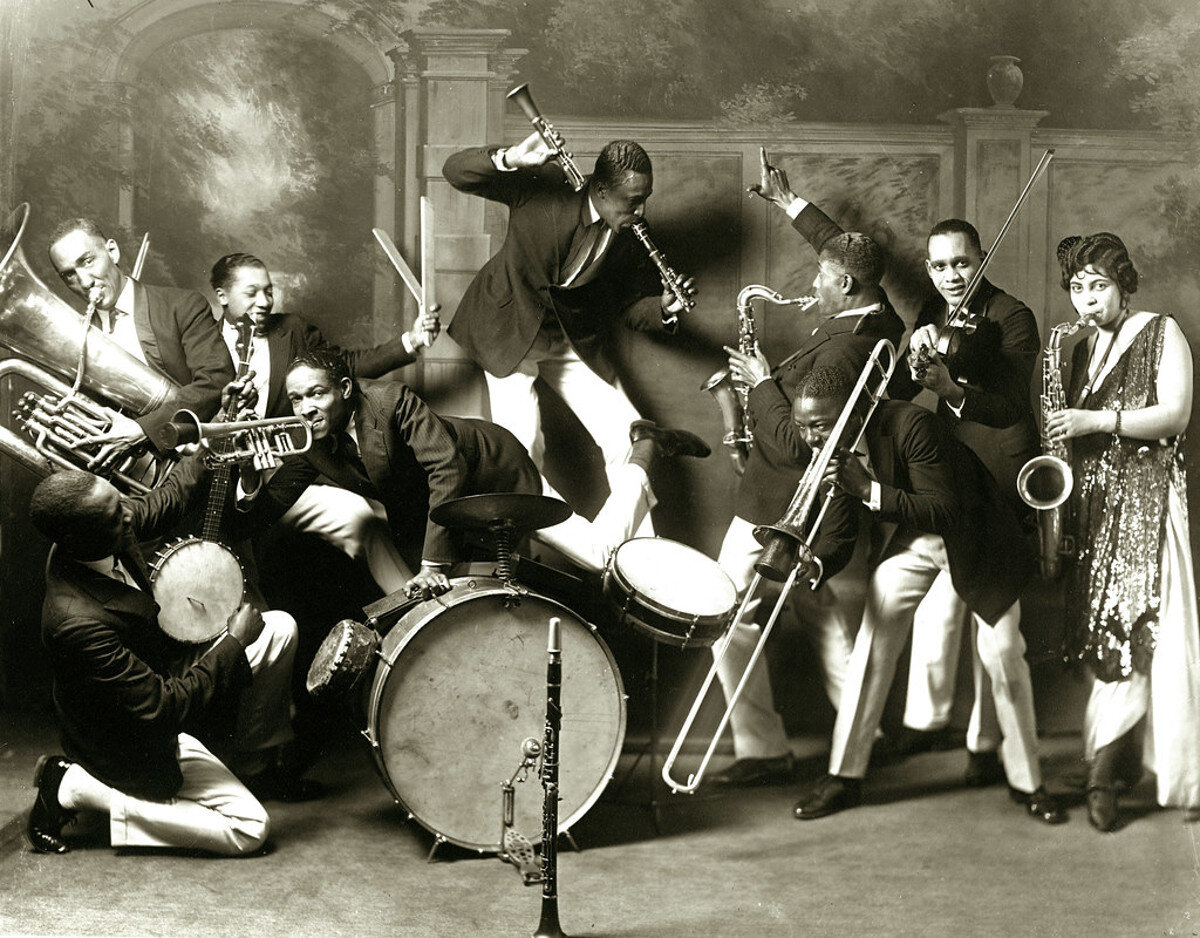
In explaining the difference in attitudes between the two cities, he averred, “St. Louis sees itself as the Westernmost eastern city in the US and Kansas City sees itself as the Easternmost western city; an example of this would be when you hear people in St. Louis say ‘Missouri,’ while most people in Kansas City still say ‘Missouruh.’” While there may be some readers from that fair state who will proclaim him full of hooey, he had a keen ear and was already in his 60s when he shared that observation. Let’s see if this statement has any bearing on our exploration!
We’ll skip the first couple of sides either band recorded; they sound sloppy and awkward on their first sessions. However, by 1924 Moten’s band was beginning to play some hot music. Hal, you listed Moten’s “Goofy Dust” as a tune to include, so please share some highlights and observations on that one from November 29, 1924 (recorded, incidentally, in St. Louis!).
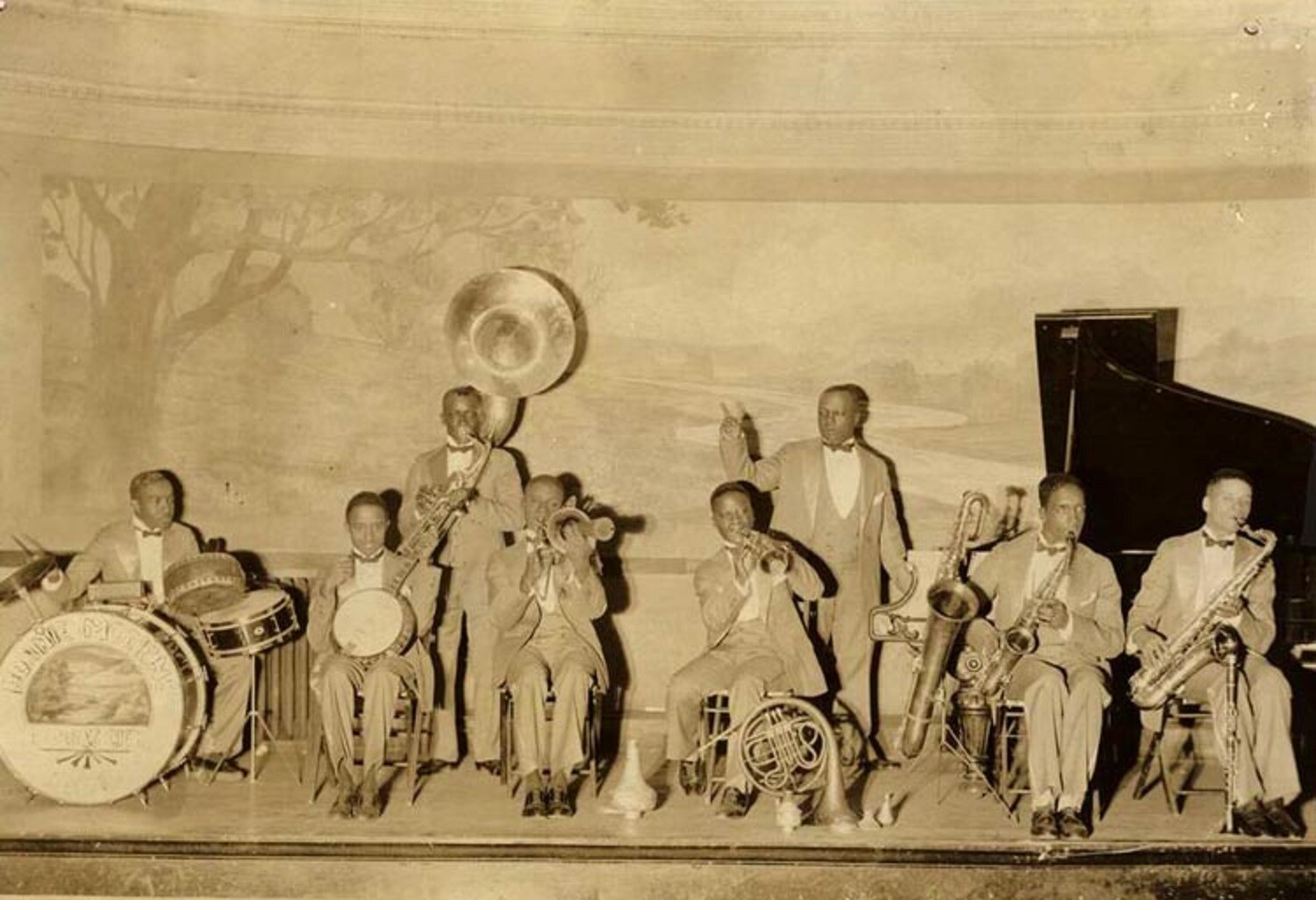
HS: “Goofy Dust” is one of my favorite recordings by the early Moten band, largely because it features the bandleader on piano. I understand that Bennie Moten was acquainted with the great ragtime composer James Scott, and that Scott became a major influence. Moten’s piano playing may give us a glimpse of how Scott himself sounded on piano. Also, the melody on the second strain is reminiscent of Scott’s compositions like “Ragtime Oriole.”
The orchestra plays with a tremendous but relaxed drive—a distinct trait of Southwestern jazz bands. For me, the outstanding voice in the four-piece front is cornetist Lammar Wright. He plays a red-hot lead but takes his time doing it. Like many other early jazz recordings, there is no bass instrument, but Moten’s big, full sound on the piano together with the banjo and traps, provide plenty of rhythmic support. Incidentally, the orchestra remade this song a few years later as “New Goofy Dust Rag.”
JB: Great observations AND ears, Hal! This piece is ragtime played by a band! In addition to James Scott’s influence, in the second strain I hear Morton as well; it’s intriguing to think, although it’s not been documented to my knowledge, of the possibility of Moten traveling to St. Louis as a young pianist and working his way into one of Tom Turpin’s post-Rosebud Cafe establishments like The Eureka Club (opened in 1910) or The Jazzland Cafe (opened in 1916). Regardless, pianists who had played for Turpin in any of those establishments would no doubt have traveled through, and performed in, Kansas City where Moten would’ve caught them. Ragtime’s influence on Moten fueled the sound of the band up until Basie, Eddie Durham, Oran “Hot Lips” Page, and Walter Page, all from Walter Page’s Blue Devils, were absorbed into the band in and around 1929.
I’m glad you bring Lammar Wright into the picture as well; after his stint with Moten, he would end up joining the Cotton Club Orchestra in 1927 (not Ellington’s) that would eventually evolve into the Missourians. By 1925, Wright had abandoned his straight playing to include the wide vibrato and almost moaning sound of New Orleans he most likely picked up from the musicians making their way north on the riverboats. And it’s his contributions (and incorporation of direct licks from Joe Oliver) that lead us to our next tune, a blues called “18th Street Strut,” recorded on May 14, 1925.
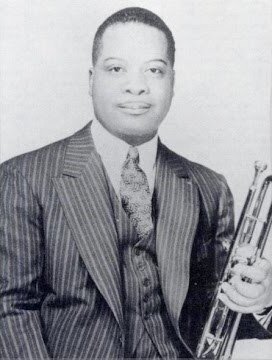
In “18th Street Strut,” Lammar Wright filches King Oliver’s solo on “Dippermouth Blues,” which is still galaxies better than the hokum perpetrated by Woody Walder and his clarinet mouthpiece solo…ouch! It’s interesting to note that of the 22 sides the band recorded between 1923 and 1926, nearly half of them were blues. Hal, what do you hear on “18th Street,” and can you also introduce “Kater Street Rag?”
HS: “18th Street Strut” is one of the lesser-known compositions by Thomas “Fats” Waller. The composer himself recorded this blues number on a piano roll for the QRS company in 1926. Notice that the Moten band has a bigger sound on this recording, due largely to the addition of Vernon Page on brass bass. Lammar Wright sounds even more like King Oliver and except for that mouthpiece solo, the front line plays magnificently. Moten kicked off a perfect tempo for this, song, too. You can easily imagine the dancers crowding the floor of one of the Kansas City ballrooms where the Moten ensemble performed.
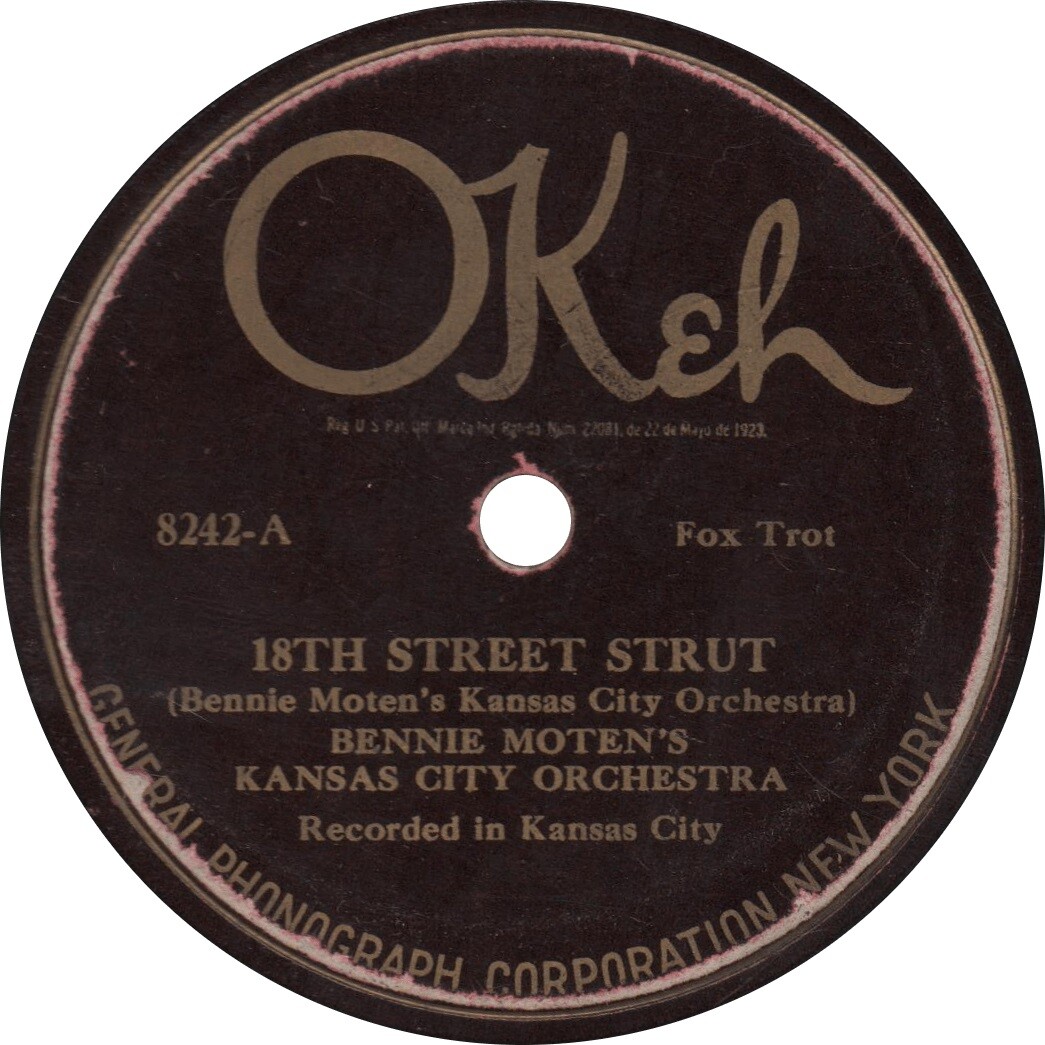 “Kater Street Rag” is one of the early Moten band’s hottest recordings. The song itself is like older New Orleans numbers like “Mama’s Baby Boy” and “Sister Kate.” In other words—a blowing tune! The Moten Orchestra made the most of the opportunity, with terrific ensembles and some of the best Lammar Wright on record! Between the strong brass bass playing and Willie McWashington’s afterbeat on the woodblock, the dancers would have no trouble figuring out where all four beats landed.
“Kater Street Rag” is one of the early Moten band’s hottest recordings. The song itself is like older New Orleans numbers like “Mama’s Baby Boy” and “Sister Kate.” In other words—a blowing tune! The Moten Orchestra made the most of the opportunity, with terrific ensembles and some of the best Lammar Wright on record! Between the strong brass bass playing and Willie McWashington’s afterbeat on the woodblock, the dancers would have no trouble figuring out where all four beats landed.
There are two wonderful piano choruses on this one and in a previous discussion, you and I commented on the similarities between Moten’s piano solos on “Kater Street” and some of Frank Melrose’s recordings. I still think that Melrose was influenced by Bennie Moten and that the “Kansas City Frank” nickname may be a result. What elements of “Kater Street Rag” appeal to you the most, Jeff?
JB: I love the carousel of styles here. Although ostensibly in two-beat style, one finds one’s foot beating in four; this recording and Moten’s others of this era seamlessly synthesize the old and the new: hot ragtime meets blistering jazz! The second section is a full-band version of a riff pianists of the era loved to utilize to build excitement, from Eubie Blake to James P. Johnson to Jelly Roll Morton, whose first theme of 1926’s “Kansas City Stomps” echoes the second theme of “Kater Street Rag” in both melodic direction and harmonic sequence.
Moten’s piano solo on the third section pays homage to the ragtime sounds and conventions he had grown up with in Kansas City and, Melrose DEFINITELY picked up ideas from him! The band barrels back with a vengeance and on the second chorus we hear Moten banging out four-to-the-bar in his left hand. In just two-and-a-half minutes, the band covers over 20 years of styles! I’ll end this one with a shout out to you and your Down Home Jazz Band, Hal. Your version on the 1997 Stomp Off release Dancing the Jelly Roll always chases away the blues.
Let’s head East now to New York City and visit the Cotton Club Orchestra, with violinist Andy Preer leading the ensemble that would become the Missourians. After making their earliest recordings, the band left St. Louis to make a name in Chicago, where they were discovered by the Cotton Club’s principal owner, Owney Madden, who liked to hire all employees from the Windy City to avoid “getting in bed with” other New York gangs. In 1925, he brought them back East.
On November 10, 1925, this group recorded two sides worth exploring. I’ll begin with “Charleston Ball,” a typical tune capitalizing on the then-dominant dance style. Close arranging between sections showcases a band used to playing for dancing and indeed this band filled the Cotton Club in the early days. A hot 24-bar trumpet solo—most likely by R. Q. Dickerson— follows the ensemble, with trombonist De Priest Wheeler finishing out the remaining six bars; his final two are interrupted by a 10-bar interlude of astonishing creativity: four bars of ensemble are followed by two-bar breaks for Wheeler (wildly wielding his mute foreshadowing Ellington’s trombonist Joe “Tricky Sam” Nanton), the trumpet of Sidney De Paris and the reed section, then returning to the main theme with breaks, surprise Charleston sections and an extended Charleston coda. Very intricate arranging here in contrast with what Moten was doing in the same period farther West.
HS: The first chorus almost sounds “Eastern”—like Fletcher Henderson’s Orchestra. But notice how everyone seems to take a deep breath, then relax as soon as the trumpet solo begins. Those musicians couldn’t shake the West-of-the-Mississippi feeling, even in New York City! The rhythm played by the banjoist is the alternative approach to hitting four unaccented beats: he emphasizes the second and fourth beats. There were several Chicago banjoists who played that way as well. Other than the solos you mentioned that saxophone solo is a knockout!
The melody on the first strain of “Everybody Stomp” (by the same group) reminds me of Doc Cook’s “Scissor Grinder Joe” but with tricky syncopations, some Charleston rhythm, a violin doubling the lead and a brief clarinet trio passage, like what Fletcher Henderson often included in his arrangements. In other words…there is a lot going on here! Jeff, what catches your ear on “Everybody Stomp?”
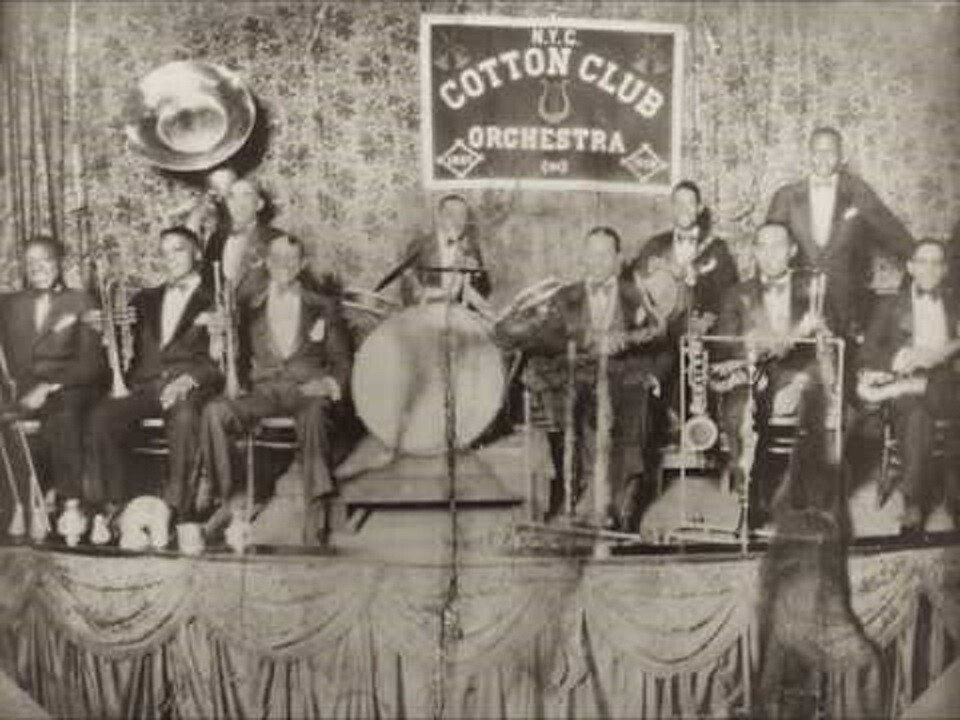 JB: The main thing is how much hipper The Cotton Club Orch. is then any other bands that recorded this tune in 1925, including the Savoy Havana Band, featuring the composer, Elmer Schoebel! The Bud Lincoln Orch, the Original Indiana Five and the Tennessee Tooters (another name for the California Ramblers) offered versions that underwhelmed me as well. THEN, this one! From the hard-hitting intro, the tune doesn’t only stomp; it struts and swaggers like the soundtrack for a late-night jazz rave. De Priest Wheeler is once again playing acid-hot trombone and that 24-bar clarinet trio segment is precise and pulsating. I was frankly surprised by the (mercifully brief) bass clarinet solo and relieved when the final ensemble roared in for a scorching finish!!
JB: The main thing is how much hipper The Cotton Club Orch. is then any other bands that recorded this tune in 1925, including the Savoy Havana Band, featuring the composer, Elmer Schoebel! The Bud Lincoln Orch, the Original Indiana Five and the Tennessee Tooters (another name for the California Ramblers) offered versions that underwhelmed me as well. THEN, this one! From the hard-hitting intro, the tune doesn’t only stomp; it struts and swaggers like the soundtrack for a late-night jazz rave. De Priest Wheeler is once again playing acid-hot trombone and that 24-bar clarinet trio segment is precise and pulsating. I was frankly surprised by the (mercifully brief) bass clarinet solo and relieved when the final ensemble roared in for a scorching finish!!
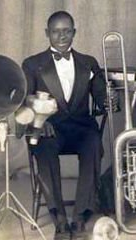
Let’s return to Moten. On Dec. 16, 1926, the band recorded 5 sides, with the standouts being “Thick Lip Stomp” and “Harmony Blues,” though the more famous “Kansas City Shuffle” was also recorded on this date. “Thick Lip” was the first side I ever heard from the group. I was hooked from the opening cymbal crash into the dramatic ensemble introduction to the first section featuring a break by tubist Vernon Page to the ensemble with McWashington’s off-beat woodblock, the repeat of A with a torrid trombone break, to the interludes (love the trumpet bending notes each time) that open for blues sections with off-beat ensemble backing solos for clarinet, trombone, trumpet (Lammar Wright getting hotter each year), clarinet (this time in minor!) to the final ensemble on A (banjo and piano breaks this time) to the Charleston coda. Whew! Hal, one of the reasons this music was so hot is that these tunes were originals, primarily composed by Moten and trombonist Thamon Hayes, so these were NOT stock arrangements. They were fresh (HOT!) off the press. What do you think of this one and the other two I mentioned?
HS: Notice that the emphasis on the second and fourth beats by drummer Willie McWashington is more pronounced than ever on all three sides. I bet the dancers really liked that! Lammar Wright once again channels King Oliver on these sides (he also quotes Oliver’s “Dippermouth” solo again on “Thick Lip Stomp”). By the way: these records were made in Chicago. I wonder if Moten’s musicians went to hear Oliver’s Dixie Syncopators while they were in town?!?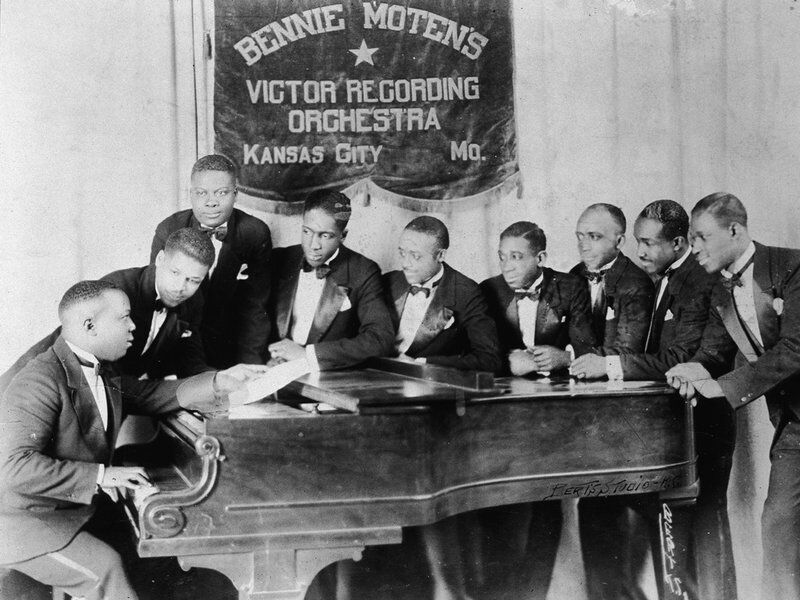
These charts include more interludes, key changes and arranged passages than the earlier sides. Moten’s musicians really nail all of it; playing with plenty of intensity but never losing that relaxed Southwestern feel.
JB: They’re in a transitional stage in 1926. While the playing is still hot, they are exploring tempos and feels…the slow “Harmony Blues” has a sinister aura throughout, a ghostly clarinet trio leads us into a two-chord section with solos from Wright and Hayes while Moten’s melancholy solo ends with a remarkable six-bar solo interlude featuring 24 chromatically descending left-hand notes to bring us back to the main theme. They’d not done anything like this before!
Contrast that with “Kansas City Shuffle”—a throwback to me. The chord progression revisits “Kater Street Rag” and the New Orleans tunes you mentioned above. The one innovation is the loping tempo; the band is maturing. Yet I can’t understand why this was one of their more celebrated tunes.
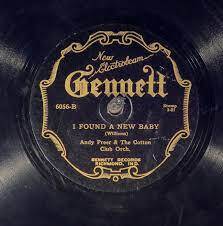 Before finishing up with a couple of Moten classics from 1927, let’s return to New York and catch Andy Preer’s Cotton Club Orchestra’s recording the now-standard “I Found a New Baby.” A fourth reed has been added and this augmentation is shown off throughout the arrangement! After a dramatic reeds-trombone-tuba intro, we have a ripping trumpet chorus sans melody over the harmonic changes. Weird! An ensemble verse leads us to a melodic chorus by the newly expanded reed section. After a brass doo-wah interlude, tenor sax man Andrew Brown plays a verse from an unrelated tune I can’t place. After a nice trumpet solo, another interlude and the reed section plays an incredibly intricate figure over stop-time hits. The part-writing almost vanquishes them, but they persevere, carrying the phrases through to the end over some restrained brass blowing. Hal, what do you observe here, and can you place the interpolated tune?
Before finishing up with a couple of Moten classics from 1927, let’s return to New York and catch Andy Preer’s Cotton Club Orchestra’s recording the now-standard “I Found a New Baby.” A fourth reed has been added and this augmentation is shown off throughout the arrangement! After a dramatic reeds-trombone-tuba intro, we have a ripping trumpet chorus sans melody over the harmonic changes. Weird! An ensemble verse leads us to a melodic chorus by the newly expanded reed section. After a brass doo-wah interlude, tenor sax man Andrew Brown plays a verse from an unrelated tune I can’t place. After a nice trumpet solo, another interlude and the reed section plays an incredibly intricate figure over stop-time hits. The part-writing almost vanquishes them, but they persevere, carrying the phrases through to the end over some restrained brass blowing. Hal, what do you observe here, and can you place the interpolated tune?
HS: That is definitely an unusual version of “I Found a New Baby.” Normally you would expect to hear something at least approximating the melody in the first chorus, but the trumpet man was just improvising over the chords. While the arrangement does include the proper verse, that unrelated tune you mentioned is the verse to “Sobbin’ Blues.” I have no idea how or why that wound up in this chart! This really is a “kitchen sink” kind of arrangement; the exact opposite of the kind that Moten and the Missourians generally employed.
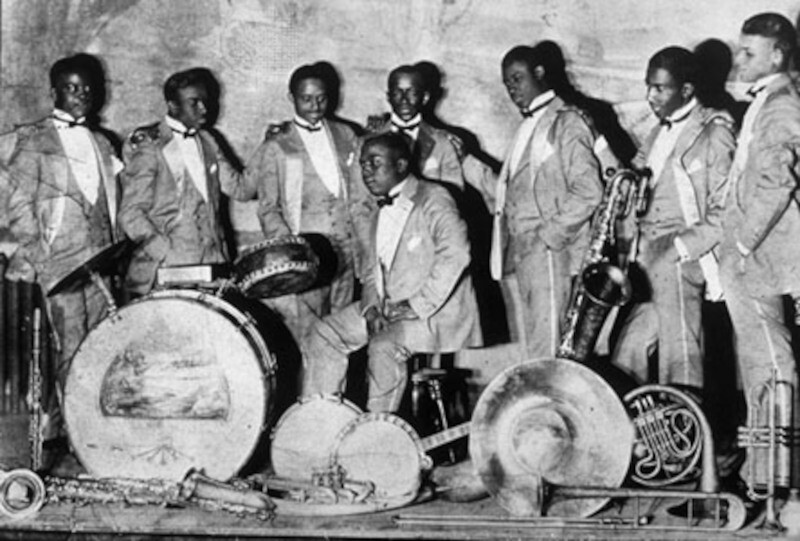
There are a couple more Moten sides recorded at the end of 1926: “Midnight Mama,” a Jelly Roll Morton composition, and “Missouri Wobble.” They are good performances, but for various reasons are not quite up to the level of “Thick Lip Stomp” and “Harmony Blues,” which were recorded the previous day. The orchestra was back in Chicago in June of 1927 for two sessions which produced some real gems. I really like “Sugar,” “New Tulsa Blues,” and “Baby Dear” from June 11. Jeff, I know you have a couple favorites from these Chicago sessions. Can you say a little bit about those records?
JB: Thanks, Hal, I’d love to. Incidentally, we’ll come back to two of the three titles you mentioned later this year when we explore bands that rerecorded their own tunes in new ways!
My favorites you refer to were recorded on June 12, 1927, a day after the five tunes (including your listed three) they had successfully rendered in the studio. On this day, they only managed to put out three sides, mainly because they had to do three takes of “Ding Dong Blues.”
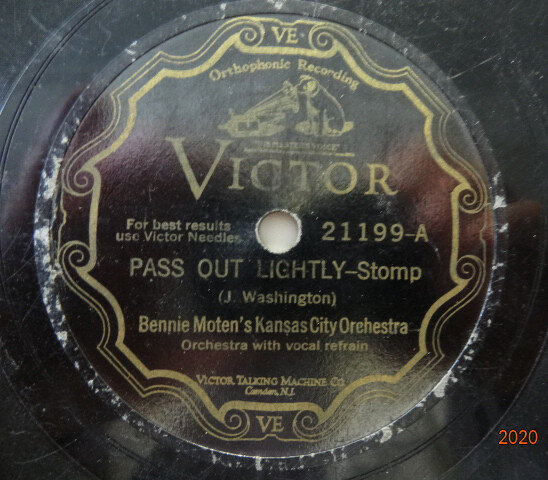 One of them, “Pass Out Lightly,” was a gasser! It was written by reedsman Jack Washington (or should I say “reedsboy,” as he was 15 when he rejoined Moten in 1927 and provided this tune; he had left Moten at age 13 to play first with Paul Banks’ band and then Jesse Stone’s Blues Serenaders). There’s not much to the melody itself; it’s basically a riff tune with simple chords to play hot over—and do they EVER! After a strange interlude of 1925’s “I’m Sitting on top of the World,” we have a molten duel between cornetists Ed Lewis and Paul Webster leading into a minor 32-bar interlude that brings us to another duel, this time between the tenor and baritone saxes of LaForest Dent and Master Washington respectively, which heads into the final chorus that unfortunately ends prematurely with an awkward, gangling (dare I say prepubescent?), honking baritone squawk…Hal, you recorded this tune with Jim Dapogny. What stands out for you here? Also, I’d love to give you first crack at Moten’s magnum opus (to this point), “Ding Dong Blues!”
One of them, “Pass Out Lightly,” was a gasser! It was written by reedsman Jack Washington (or should I say “reedsboy,” as he was 15 when he rejoined Moten in 1927 and provided this tune; he had left Moten at age 13 to play first with Paul Banks’ band and then Jesse Stone’s Blues Serenaders). There’s not much to the melody itself; it’s basically a riff tune with simple chords to play hot over—and do they EVER! After a strange interlude of 1925’s “I’m Sitting on top of the World,” we have a molten duel between cornetists Ed Lewis and Paul Webster leading into a minor 32-bar interlude that brings us to another duel, this time between the tenor and baritone saxes of LaForest Dent and Master Washington respectively, which heads into the final chorus that unfortunately ends prematurely with an awkward, gangling (dare I say prepubescent?), honking baritone squawk…Hal, you recorded this tune with Jim Dapogny. What stands out for you here? Also, I’d love to give you first crack at Moten’s magnum opus (to this point), “Ding Dong Blues!”
HS: Just counting the introduction on “Pass Out Lightly” is a challenge! As you mentioned, there are some unusual aspects to the arrangement—especially the chase choruses and the minor section which seems to come out of nowhere. What I like most about the record is the drumming; “Willie Mac” mixing afterbeats on the woodblock with thumps on the tom-tom and rock-solid choke cymbal on the last chorus. The ending sounds like a Canada Goose who has been separated from the flock!
The melody of “Ding Dong Blues” sounds like a pop song from an earlier era—like Jelly Roll Morton’s “Good Old New York” and Hayes Alvis’ “Blue Nights.” We hear a Charleston beat, then the whole rhythm section playing offbeats behind the trumpet (and into the trombone solo); “sock time” phrasing on the sax solo and a kazoo/vocal chorus backed by just piano and drums before the final blowout. This arrangement rivals the Cotton Club Orchestra chart on “I Found A New Baby” for including so many diverse elements!
JB: The solos are hot, the chord sequence inventive. For me this side represents a blending of the old (those quasi-classical interludes between solos) and, for the time, the very modern! Moten’s barrelhouse piano under the hokey (yet HOT) vocal/kazoo chorus kills me, as does that final chorus where the saxes limpidly lay down the melody as the brass syncopates with wild abandon—listen to Ed Lewis breaking free with those high notes just before the coda. My favorite side from 1927!
Next month, let’s devote our attention to the 11 sides the Missourians recorded in 1929-30 and see why they were the punk rockers of their era, 45 years before that term appeared!
Jeff Barnhart is an internationally renowned pianist, vocalist, arranger, bandleader, recording artist, ASCAP composer, educator and entertainer. Visit him online atwww.jeffbarnhart.com. Email: Mysticrag@aol.com
Hal Smith is an Arkansas-based drummer and writer. He leads the El Dorado Jazz Band and the
Mortonia Seven and works with a variety of jazz and swing bands. Visit him online at
halsmithmusic.com
























